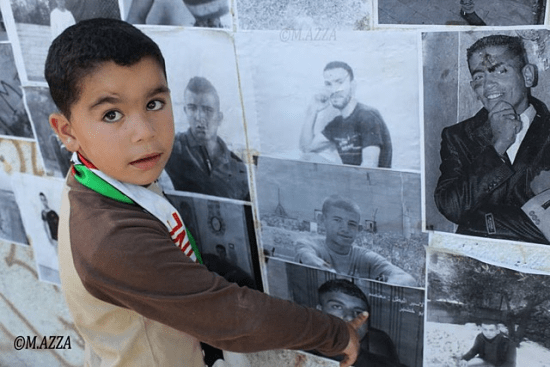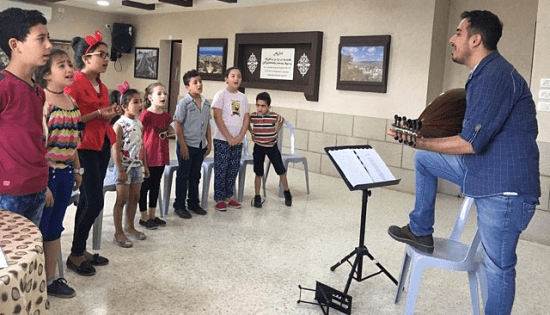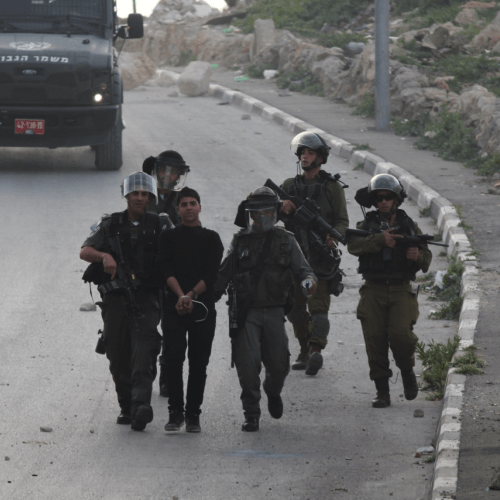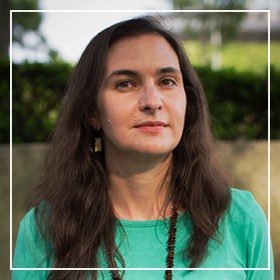A staff member at Lajee Center, a youth organization in Aida Refugee Camp in the Israeli occupied West Bank, went “live” on Facebook on the afternoon of Sunday, February 5, 2017, as soldiers entered the building. In his video, later watched by people on at least three continents, viewers can see the Israeli soldiers wearing helmets with face shields and, as usual, brandishing M-16s amidst the Palestinian twenty-somethings in street clothes. They brandish only their smartphones. The soldiers say something about yeledim (Hebrew: children) and the Palestinians respond talking about awlad (Arabic: children). Then they settle into English: A soldier inquires after the “Boy? Little boy with, ehh…”. One of the staff members replies crisply, “There is no little boy here.”
Maybe there are no children at all. In 1988, after two decades of Israeli military occupation of the West Bank and Gaza Strip, Palestinian writer Anton Shammas wrote, “for twenty years now officially there has been no childhood in the West Bank and the Gaza Strip… a ten-year-old boy shot by the military forces is reported to be a ‘young man of ten.’” Now these children who were never children have grown up and have children who themselves are not children. Yet, Lajee Center and youth organizations like it throughout the occupied territory insist on creating a public space for Palestinian childhood. This is true even though NGOs, Palestinian and others, have often played a depoliticizing role (Ferguson 1994; Hammami 1995; Hanafi and Tabar 2005).
Lajee Center does its work in the face of constant harassment, or worse, from the Israeli army. In the last eighteen months, Israeli soldiers have thrown tear gas into the Center, detained a librarian in her office, broken surveillance cameras, seized young men who were assembling a playground in the Lajee Center garden, shot tear gas into the youth center while youth were inside, and beaten and detained the director of Lajee Center Media Unit. On Feb. 7, two days after soldiers came looking for the “little boy” referred to above, they confined three staff in an office and absconded with two computers, including the one with the footage from a surveillance camera out front that staffers worried might incriminate protesters. (A Lajee Center staff member posted this video on a personal account as well.)
This month, we mark 50 years of Israeli military occupation of the West Bank and Gaza Strip. So many decades into this regime of violence, which has compounded Israel’s foundational settler colonial project, it is difficult to discern the motivations for various Israeli acts of aggression. They layer on top of each other, a palimpsest of militarism, political repression, and racism. Do soldiers attack the youth center because it is, to the Israeli army, part of a territory that must be “pacified,” and thus it is indistinguishable from the streets and houses and shops? Is it because, as a functioning institution of civil society, Lajee poses an ideological threat to Israel? Or is it because soldiers, steeped in societal racism and protected by what B’Tselem calls Israel’s legal “whitewash mechanism,” can attack Lajee with impunity?
To try to understand military occupation is to uncover a multiplicity of forms of what Achille Mbembe has termed the necropolitical (Mbembe 2003).
In part, Lajee Center is under attack because all of Aida Camp is so often under attack. As Amani Asad, a human rights educator at Lajee and a lawyer, explained, “They attack the Center from all directions. They attack the camp, and the Center is part of the camp. And they attack the Center, as a Center.” Aida Refugee Camp, on the northern edge of Bethlehem, is home to about 5,500 refugees whose families were dispossessed of their land 69 years ago with the establishment of Israel. Aida Camp, located about 5 kilometers from the Green Line, is enclosed by the separation wall on two sides. In Aida, that wall is an 8-meter high concrete structure, with about four watchtowers embedded into it. Unemployment is high, and the population is overwhelmingly young. Statistics about Aida are hard to confirm, but the United Nations Relief and Works Agency (UNRWA) reported in recent years that unemployment was at 43% and 60% of the population was under the age of 25 (UNRWA 2010).
People in Aida Refugee Camp live under the weaponized surveillance of the Israeli military base at Rachel’s Tomb—itself another palimpsest, as Rachel’s Tomb is at once a mosque, a Jewish shrine, an Israeli military base, and a station in Israel’s separation wall (Bowman 2013). To guard their colonial base, the soldiers have installed cameras and cut down trees in the adjacent cemetery so that they can see residents better. People live their lives peering at the soldiers in the graveyard of which Rachel’s Tomb was once a part, rushing to close their windows from tear gas, listening to the variety of gunshots and other military explosions that pierce so many days and nights.
In response to decades of dispossession and militarization, residents of Aida Camp, like residents of many other Palestinian refugee camps, have launched waves of resistance (Alazzeh 2014; Collins 2004; Lockman and Beinin 1989). In Aida, the latest started in the fall of 2012 during Israel’s attack on Gaza. In January 2013, youth burned, drilled, and hammered a hole in the separation wall around the camp. A massive wave of arrests ensued. Since then protests have paused, but never entirely stopped. After the Israeli army arrested youth in their late teens and early 20s, even younger boys started protesting. At a time when the Palestinian Authority (PA) lacks a strategy for resistance and enjoys little legitimacy, it is left to youth to throw stones and Molotov cocktails at the local military base. They express their rejection of military occupation and maintain a culture of resistance even though the risks they take are not part of a coordinated movement, as protests have been at other times and places.

Salah Ajarma, executive director of Lajee and a life-long resident of Aida, explains the Israeli army presence in the camp as follows: “The presence of Rachel’s Tomb and the tower close to a population center creates a confrontation point at which youth resist the presence of the occupation. The army comes on calm days to incite violence, too. They know this is a neglected area. This is also sometimes training for the army.” To the extent that Lajee is under attack like all of the camp is under attack, we can think of tear gas as a metonym: The soldiers shoot it in great quantities, and so the protester, the grandmother, the youth center staffer, and the baker are equally likely to be affected by it.
But Lajee Center, established in 2000, is also under attack as an institution. Why does the army attack a youth center? Because the Israeli army is fighting children. 300 Palestinian children are in Israeli detention, and they are systematically mistreated. Children of the camp know they can find at Lajee adults who firmly but decisively stand up to the army on their behalf. When soldiers infiltrate the center itself, staff members try to protect those inside from arrest.
Lajee Center asserts that children should be treated as children with its programming.
Lajee Center – like other small NGOs throughout occupied territory – opens the public and political possibility of childhood and helps to strengthen other social forms such as the family and the community. Whenever possible, staff members keep the playground open, run music lessons, carry out dance lessons, help youth tend greenhouses, and read books aloud.

From Aida Camp, it is clear that Israeli soldiers regard Palestinians only and always as threats. When soldiers detained librarian Kifah Al-Ajarma on July 14, 2016, she recalled their conversation. “I said, ‘We are a children’s organization. We have no relationship with whatever [demonstrations] are going on.’ And he said, ‘The children you teach, how old are they?’ I said, ‘We work with children of all ages. They are still children until they turn 18.’ He replied, ‘Those who are 10 years old are not children.’” The Convention on the Rights of the Child confirms Al-Ajarma’s definition. Anyone under 18 is a child. Palestinians are no exceptions.

Lajee Center also provides ways for youth to participate positively in Palestinian civil society. For example, political imprisonment affects Aida Camp drastically. Lajee Center staff recently counted 76 people in Israeli prison from Aida Camp, including many teenagers. Virtually everyone has a relative who is or has been in prison, or a relative that they worry may be snatched during the Israeli army’s middle of the night raids. During the prisoners’ hunger strike for better conditions that began on April 17, 2017, youth from Lajee Center’s music troupe performed in front of prisoners’ parents, former prisoners, and other community members to honor the strike. They joined processions in the city in support of the prisoners.
The army also attacks Lajee because Aida is in the midst of a war over territory, a microcosm of the conflict as a whole. By its very presence on the edge of the camp, Lajee Center has held land for Palestinians that would otherwise have been taken by the army. As Nidal Al-Azza, director of the refugee rights organization Badil, a founder of Lajee Center, and a camp resident, wrote in an email, “Within the last years, Lajee has succeeded in creating a concrete fact on the ground challenging what Israel created… Israel wanted to force people to move out of the area and to create a de-facto buffer zone between the military compound/Rachel tomb and the camp… By the establishment of Lajee office and then the garden in that area, as well as conducting public activities, Lajee succeeded not only in challenging this buffer zone…, but it [also] revived the area.”
Lajee contributes to the war of ideas as well, and in this way has an impact far beyond Bethlehem. As the director of Lajee Center’s Media Unit, Mohammad Al-Azza remarked when I asked him why the army attacks his workplace, “They don’t like our work: We document everything that happens in the Center.” International delegations visit Lajee to receive tours and hear about refugee rights and the workings of the occupation. International organizations rely on their eyewitness reporting.
Holding ground and recording Israeli violence are related projects: On October 29, 2015, camp resident and Lajee dance troupe member Yazan Ikhlayel stood on the balcony of the center and recorded a soldier threatening to gas the people of Aida until they died. (Residents know to take this seriously. In April 2014, Nuha Qatamish, a mother in her 40s, suffocated to death as a result of tear gas.) The war of representation is inextricable from the war of position. On April 8, 2013, Israeli soldiers shot Media Director Mohammad Al-Azza in the face as he was taking pictures of a routine Israeli operation from the Lajee Center balcony.
There is another logic as well, hinted at in the soldier’s loudspeaker declaration that he will gas the people of Aida until they all die: After 50 years of occupation, the army enjoys impunity; its actions cannot be understood outside of a context of racism. The combination seems to breed as many petty despots are there are soldiers. For example, Israeli soldiers detained playground workers who were assembling a new structure on July 17, 2016, to ask them about resistance activities they may have seen. Though they were not suspects, they were treated as enemies and criminals. When one of the men detained, Firas Nasrallah, asked for water, a soldier told him to be quiet, and then demanded he take off his shirt. When Nasrallah asked why he should take off his shirt, Nasrallah recalled the soldier saying, “Just because. Because I want you to. I am free to do anything I want, and I want you to take off your shirt.”
We cannot write off this racism and impunity as a side effect of power, since it is also precisely the point.
Lajee Athletics Director Hamada Al-Kurdi said that during the late fall of 2016 soldiers often came to search the players and close the field. On December 17, 2016, when Media Unit director Mohammad Al-Azza came down from his office to check on the soccer players being harassed by the soldiers, other soldiers stopped him in the street. They pointed and cocked their automatic rifles at him. He recorded the encounter on his phone. Moments later, soldiers beat him to take his phone. When he refused to give them the password to open the phone, they beat him more. Al-Kurdi looked on. “It was a severe beating,” he recalled with astonishment. This is the spectacular violence of sovereignty taken down to the dirty, mean level of the street beating. Everyone knows it can happen at any moment. The soldiers then took Al-Azza to the military base, where an officer beat him again. Al-Azza asserted to the officer that he had a right to record these events, as an employee and a journalist: “These youth are under our protection, and plus I am a journalist and I need to do my job.” The officer looked askance at Al-Azza’s phone, as though to doubt it could be a professional instrument or that Mohammad himself could be a professional. He replied that Al-Azza was not working at the time, and Al-Azza replied, “I am always at work.” He is always at work because Israeli violence is omnipresent.
A recent report from Badil, the refugee rights organization, on “Suppression of Resistance” argues that Israel suppresses resistance in part “by creating an atmosphere of coerciveness, duress, and psychological oppression that leaves those subjected to these policies with no option but to leave their homes.” Lajee and community centers like it throughout the West Bank give children and youth a reason to stay. They even present ways for them to live with dignity and creativity under occupation. But for their resistance, they face threats every day.
Israeli violence repeats itself in all-too-short cycles. On May 23, 2017, Israeli soldiers rounded up about 20 youth from Aida and beat them on the street before releasing most of them. The next day they invaded Lajee Center again; again a staff member livecast the soldiers in their main office, and again the soldiers took a computer that recorded surveillance camera footage.
After fifty years, the daily brutality of Israeli occupation continues. According to Defense for Children International-Palestine, nine Palestinian children have been killed by Israeli forces this year. In Gaza, children have grown up under siege interrupted only by a series of wars. And inside Israel, 52.6 percent of Palestinian families lived in poverty in 2014, compared to 18.8 percent of all families. There, too, children’s right to expression is endangered, and children have faced detention for practicing their civil right to protest. Diplomatic efforts to end the occupation have been fruitless for too long, and the state of diplomacy only promises to become grimmer in the coming years. Armed resistance to end the colonial occupation has not succeeded, and popular revolt has faltered. Volunteers and staff at Lajee often tell visitors that the boycott, divestment, and sanctions movement (BDS) offers a way forward for Palestinians from many locations to work with an international community for Palestinian rights. In the meantime, many Palestinians are often grateful for small institutions like Lajee that make civic life possible, and that may build toward a more just future.
References
Alazzeh, Ala. 2014. “Locating Nonviolence: The People, the Past, and Resistance in Palestinian Political Activism.” Ph.D. Dissertation. Houston, Texas: Rice University.
Bowman, Glenn. 2013. “A Weeping on the Road to Bethlehem: Contestation over the Uses of Rachel’s Tomb.” Religion Compass 7 (3): 79–92.
Collins, John. 2004. Occupied by Memory: The Intifada Generation and the Palestinian State of Emergency. New York City: New York University Press.
Ferguson, James. 1994. The Anti-Politics Machine: ’Development,” Depoliticization, and Bureaucratic Power in Lesotho. Minneapolis: University of Minnesota Press.
Hammami, Rema. 1995. “NGOs: The Professionalization of Politics.” Race & Class 37: 51–63.
Hanafi, Sari, and Linda Tabar. 2005. The Emergence of Palestinian Globalized Elite: Donors, International Organizations, and Local NGOs. Jerusalem: Institute of Jerusalem Studies.
Lockman, Zachary, and Joel Beinin, eds. 1989. Intifada: The Palestinian Uprising Against Israeli Occupation. Boston: South End Press.
Mbembe, Achille. 2003. “Necropolitics.” Public Culture 15 (1): 11–40.
UNRWA, (United Nations Relief and Works Agency). 2010. “Aida Refugee Camp.” n. http://www.unrwa.org/etemplate.php?id=104.





